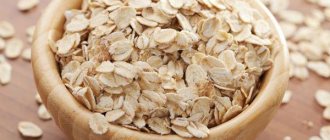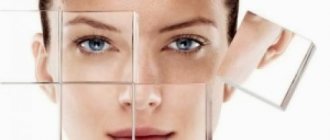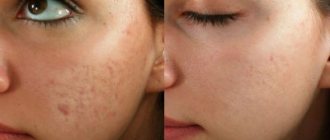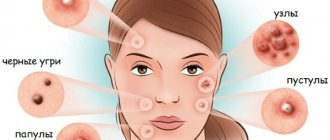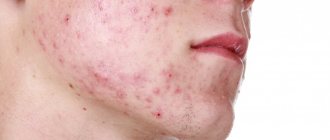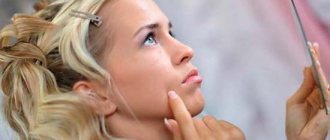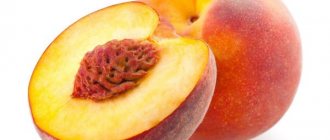Most pimples that appear on the skin of the face and body leave marks - unsightly red spots. The main reasons for their occurrence are:
- late stage of skin disease;
- getting rid of acne on your own (squeezing);
- incorrectly selected therapy;
- allergic reactions;
- lack of proper care for the skin of the face and body.
The main cause of spots is considered to be self-extrusion, which leads to disruption of the integrity of the epidermis. The characteristic red color is given to the spots by melanin, a pigment actively produced during inflammatory processes.
To solve this problem, the pharmaceutical and cosmetology sectors have developed many products aimed at improving the appearance of the skin. Traditional medicine is not far behind, offering simple and accessible methods of getting rid of such defects. The best results are achieved by an integrated approach that combines pharmaceuticals and traditional medicine.
Most of the proposed methods have proven their effectiveness in practice. The choice of funds should be based on the following factors:
- reasons for the formation of red spots;
- the time required to solve the problem;
- drugs previously used for treatment;
- price;
- recommendations of the treating or supervising physician.
How to Avoid Red Acne Spots
One of the most effective ways is prevention. To prevent the appearance of red spots, measures such as:
- daily treatment of all foci of inflammation on the dermis;
- complete exclusion of squeezing out inflammatory elements;
- use moisturizers with SPF protection of at least 25.
Instead of thinking about how to get rid of stubborn spots, you can prevent acne from appearing. To do this, it is enough to identify the causes of acne.
So, in case of hormonal imbalance, you can contact a specialist who will prescribe the appropriate treatment. Nutrition also has a great influence on the condition of the dermis. And, of course, you shouldn’t forget about proper 3- or 7-step skin cleansing.
By adjusting your diet, you can prevent the appearance of acne.
WHAT IS POSTACNE
Inflammations leave behind various persistent changes in the skin, which are collectively called “post-acne.”
5 reasons for post-acne appearance
- Protracted acne - constant inflammation changes the structure of the skin, and the longer the inflammation lasts, the deeper layers of the skin are damaged;
- Deeply located single inflammations - forming immediately in the lower layers of the skin, they almost always lead to changes in pigmentation, tissue compaction or the appearance of scars;
- Improper care for problem skin - an attempt to squeeze out pimples on your own and a lack of regular cleansing of the face only drives inflammation deeper, leading to irreversible changes in the epidermis;
- Ignoring peeling - exfoliating procedures should be started as early as possible: getting rid of fresh scars and small pigmentations is easier than treating old post-acne marks;
- Slow regeneration – today acne is a “growing up” disease. And if in teenagers it usually goes away without a trace, then at an older age, when all the recovery processes in the body slow down, acne will definitely leave behind unpleasant consequences.
Post-acne forms
Post-acne manifests itself in the form of quite recognizable signs:
| SCARS (most often in the form of indentations) | They are a consequence of rough removal of foci of inflammation or are caused by stagnation of pus in the deep layers of the skin |
| EXTENDED PORE | Appear due to a decrease in the production of collagen fibers and a decrease in the elasticity of the epidermis |
| erythema (abnormal skin redness) and dilated capillaries | Occur due to the fact that the disease disrupts the functioning of blood vessels and blood microcirculation |
| DISCHROMIA (change in pigmentation) | The disease leads to disruption of pigment production. Excess melanin can be deposited in both the epidermis and dermis, which must be taken into account when peeling |
We recommend: Pros and cons of GRAPE PEELING FOR FACE
Effective creams and gels for removing marks on the face
Cosmetics are one of the most effective drugs that can solve the problem of post-acne.
Derma E
A cleanser that can get rid of acne stains. The main advantages are:
- ease of use (used during the washing process);
- natural composition (aloe vera, chamomile, seaweed, vitamin E);
- saving time (does not require pre-cleaning of the skin).
The entire series of Derma E cosmetics is produced only using organic natural ingredients.
The raw materials used to produce this product are not subject to genetic modification and are not treated with pesticides. The only negative is the high cost of funds. Since the manufacturer is from the USA, the price of cosmetics depends on the dollar exchange rate.
Alba Botanica
One of the most common means of combating acne spots and scars is scrubs. Since spots are essentially accumulations of dead skin cells, scrubbing allows you to get rid of this “dead weight”. However, most products of this type have an aggressive effect on the epidermis. Alba Botanica is a successful exception. This drug has a natural composition, as well as other advantages:
- does not damage the upper layer of the dermis, while effectively removing dead cells;
- destroys harmful organisms (antibacterial effect);
- evens out skin color;
- cleanses and tightens pores.
Visine. pure tear
A very unexpected remedy for getting rid of the consequences of acne. The initial purpose of the drug is to relieve corneal discomfort. But this is the remedy recommended by dermatologists to combat scars and spots after acne.
Visine can be used in 2 ways:
- as a compress;
- as a means for wiping the skin.
When making a compress, it is enough to apply a few drops of the drug on a gauze pad and apply it to the problem area for 10-15 minutes. The result can be observed immediately after the first use.
For wiping, you can use a cotton pad with the product, locally treating inflammation with it. In this case, the effect will appear a little later.
Skinoren
A drug based on azelaic acid not only treats acne, but also solves the problem of post-acne. Skinoren has several types of effects:
- antiseptic;
- keratolic;
- antibacterial;
- depigmenting.
Used for a course of 1.5 to 6 months. Apply only to cleansed skin 2 times a day.
Zinc ointment
This remedy has been known since the times of Soviet pharmacies and is actively sold in Russia. The main active ingredient is zinc oxide, which has the following effects on the skin:
- dries out the epidermis;
- stimulates restoration processes in cells;
- disinfects;
- reduces the rate of sebum production;
- improves skin elasticity.
The ointment is applied only to inflamed areas and is not suitable for people with sensitive skin. Another advantage of the product is its low price.
Sledotsid
Cream-gel with a rejuvenating effect that allows you to get rid of small scars. It includes:
- hyaluronic acid (anti-aging effect);
- green tea and arnica extract (tonic and calming effect);
- tea tree oil (antiseptic effect).
The product is applied in a thin, even layer at least 3 times a day. Not only moisturizes, but also restores dermal cells.
Why do acne leave marks?
Acne marks can be completely different:
- red
- purple
- blue
- brown
- pink.
If the skin remains smooth after a pimple and you are only concerned about its changed color, then getting rid of such a mark will not be difficult.
If, after acne, a kind of scar has formed on the skin in the form of a changed structure of the skin - that is, a convex part or, conversely, a depression, then removing such a scar is much more difficult. But why do they appear? Why doesn't the skin heal completely after inflammation? Here are some causes of acne marks.
- Traces remain after deep acne, when inflammation has affected not only the upper but also the lower layers of the epidermis. After boils, marks remain on the skin much longer.
- If acne covers too much of the skin, one large inflamed area forms on the face. With such a lesion, marks on the skin disappear for at least a month.
- If we are talking about purulent pimples, they heal much more difficult, since after their removal a deep crater remains on the skin.
- Often marks on the skin remain due to the fact that we squeeze out a pimple with our hands, injuring an already inflamed area of skin. Sometimes such homemade treatment leads to infection of the wound, germs from dirty hands get inside the pimple, inflammation and damage to neighboring tissues increases. Of course, the marks from such acne will take much longer to heal.
- Traces may be on the face if the pimple has healed just recently; during the process of granulation, the wound may have a changed pigment or structure. In this case, only time will help - in a few weeks such marks will go away on their own.
- An insufficient amount of vitamins C, E, A and group B leads to the fact that regenerative processes take place in a slow manner. That is, the skin has nowhere to get resources for restoration.
- When the fat balance is disturbed and the sebaceous glands are blocked, metabolic processes in the skin do not occur intensively enough, which slows down the process of tissue restoration. With oily skin, acne marks take much longer to heal.
- With hormonal changes in the body, the skin also takes a very long time to recover due to an excess of androgens.
- Sometimes prolonged healing of acne and tissue can be a consequence of the individual characteristics of the skin. If by nature you have a very thin and light epidermis, inflammation penetrates into deeper layers, any trace of a pimple will take much longer to disappear than in a person with a normal skin type.
Remedies to get rid of age spots
Pigment spots often appear after self-removal of pimples and acne. Special creams work effectively against them.
Melantiv
The main active ingredient of the cream is ericoline - an element obtained from bearberry or lingonberry leaves. Combined with hydroxy acid, it not only cleanses but also whitens the skin.
The main advantages of Melantiv cream are:
- ability to fight post-acne of different ages;
- depigmentation properties.
The cream is applied in a light and thin layer to cleansed skin, only to the affected areas.
Treatment is carried out in the evening, just before bedtime. Do not apply whitening cream to injured dermis (scratches, wounds). Melantiv is used together with creams with SPF factor.
Neoton
The combined composition of the cream includes:
- licorice root extract;
- hydroacid;
- polyethylene glycol.
Cream for age spots not only treats existing ones, but also prevents the appearance of new ones. The whitening property is successfully complemented by the moisturizing property. Neoton is applied to well-cleaned skin in the morning before applying makeup. The main disadvantage of the product is the price (from 1200 to 2000 rubles).
BEST SALON PEELINGS FOR POST-ACNE
Cosmetology salons offer a variety of procedures aimed at getting rid of the consequences of inflammatory skin diseases. Let's look at the most popular of them and decide which peeling best fights post-acne.
Carbon peeling
Carbon peeling for post-acne belongs to the category of laser peels and has a superficial effect. It got its name because of the nanogel, which contains carbon dioxide and is applied to the face before laser treatment.
We recommend: 16 PEELINGS FOR VAUSIONS
Exfoliation is based on the interaction of laser and carbon:
- The nanogel penetrates the skin;
- The laser beam releases gel particles that have penetrated the skin and, in fact, explodes them;
- A mixture of waste carbon, impurities and dead cells is removed through heat.
The main goal of the procedure is to cleanse pores, break up comedones and stagnant sebum (secret of the sebaceous glands). Several sessions are usually required to achieve the effect.
Carbon laser peeling has the following advantages:
- Painless;
- No significant peeling, redness or swelling;
- Effective removal of congestion in pores;
- Can be used for rosacea and rosacea.
At the same time, the procedure is not a panacea for all ills:
- Has little effect on the production of collagen and elastin;
- Does not remove scars;
- The effect of cleaning pores is temporary, the skin will still require proper care;
- For some time, fat continues to be actively released from the pores.
- The procedure will cost a pretty penny.
Mesopeeling
This chemical exfoliation differs from others in that the composition is immediately introduced into the skin to a depth of 1-2 mm. Those changes that external peelings cause with aggressive methods, mesopeeling activates from the inside, as if integrating into the natural processes of skin renewal.
Various acids (glycolic, retinoic, lactic, salicylic) can be used as an active substance in mesopeeling. The choice of acid depends on the desired effect and individual skin reactions.
Cream for stagnant spots after acne and post-acne
Congestive spots can appear at any age. They are more difficult to bleach than regular ones, but this is not to say that this task is impossible.
Horrophyll-carotene paste
The product has a wide spectrum of action:
- relieves inflammation;
- narrows pores;
- heals wounds;
- removes swelling and hyperemia;
- eliminates sebaceous plugs;
- resolves stagnant spots.
It is used in the form of a mask, which is applied to the cleansed dermis for 10-15 minutes. The course includes 15-20 applications once every six months. The best time to use is spring and autumn.
Cream “Protection and Moisturizing”
Designed to protect sensitive facial skin.
The composition of the “Protection and Moisturizing” cream includes:
- emollient;
- octyldodecanol;
- titanium oxide;
- glycerol;
- golden root extract;
- polypeptide;
- methylated phenols;
- glutamic acid salt;
- Siberian noctule extract;
- aquilegia;
- sodium hyaluronate;
- lemon balm extract;
- chamomile flower extract;
- rutoside;
- sodium polyacrylate;
- synthetic tripeptide;
- palmitoyl oligopeptide;
- palmitoyl tetrapeptide-3;
- benzyl alcohol;
- benzoic acid;
- sorbic acid;
- bisabolol;
- perfume.
- This product is used for delicate skin and helps protect against adverse environmental influences. The complex composition of the “Protection and Moisturizing” cream can be used against age spots after acne.
- It should be used in the morning after preliminary cleansing of the face. Before going outside, apply the cream with light movements.
- The cost of the “Protection and Moisturizing” cream ranges from 190 rubles. up to 230 rub. for 1 bottle.
How to remove stains at home
In addition to cosmetic and pharmaceutical preparations, there are many folk remedies, the main advantage of which is their naturalness and safety.
Parsley decoction
This skin whitening product is prepared as follows:
- A medium bunch of parsley is finely chopped.
- Pour in 1 liter of hot water (boiling water).
- The decoction is infused for 1 hour.
- Cool to room temperature and pour into molds or ice bags.
It is necessary to wipe the skin with ice broth up to 3 times a day. Thanks to this, the overall tone is evened out and skin defects are eliminated. Find out the recipes for parsley masks at the link.
Scrub based on honey and soda
The recipe for making soda-honey scrub is quite simple:
- Mix 20 grams of baking soda and 20 grams of flower honey.
- Leave for 30-40 minutes to infuse.
You can treat your skin with this product no more than 2 times a week. The scrub removes pigmentation and fights blackheads. Find out about the best masks with soda here.
Considering the allergenicity of the components, it is advisable to consult a dermatologist before use.
Cinnamon honey mask
Cinnamon-honey mask is a good remedy for combating stagnant spots. This is a safe method that allows you to remove dead cells without damaging the epidermis. To prepare it you need:
- mix 1 teaspoon of ground cinnamon and the same amount of liquid honey;
- apply the mixture to the affected areas (the skin must first be cleansed);
- leave for 20 minutes, then rinse with warm water without soap.
Lemon juice
For subtle neoplasms on the skin, it is advisable to use lemon juice. Find out about masks with lemon in the article. It has a pronounced whitening effect and is easy to use. It is enough to wipe your face with a slice of fruit 2-3 times a day. But there are a number of restrictions:
- The product should not be used by people with allergies to citrus fruits and hypersensitive skin;
- Do not use the product on open wounds and scratches.
Aspirin and honey ointment
You can quickly relieve red inflammation on the skin using a homemade ointment made from honey and aspirin. You can find out about masks with acetylsalicylic acid here.
Making recipe:
- 2 aspirin tablets are crushed into powder and dissolved in a small amount of water;
- the resulting aspirin emulsion is mixed with 1 teaspoon of honey;
- The prepared ointment is rubbed into the skin of the face with very light massage movements for 3-5 minutes;
- washed off with cold water.
The product is often used after preventative cleansing of the facial skin.
HOW CAN PEELING HELP
Acne scar peeling combats blemishes by peeling off the top layers of the skin. Such an intervention removes neoplasms, triggers the restoration and protective mechanisms of cells, which together allows you to get rid of post-acne.
It must be remembered that all types of exfoliation are contraindicated in active inflammatory processes. Therefore, before you begin to fight the consequences of acne, it is necessary to cure the disease itself.
How to tighten enlarged pores
It is always better to trust the care of problem skin to specialists. But minimal prevention of enlarged pores can be done at home.
Effective scrubs and surface-acting chemical exfoliants will help keep pores clean, eliminating excess oil, makeup residues, and impurities, thereby making them less noticeable.
Medium facial peeling helps to achieve significant narrowing of pores.
By causing controlled trauma to the skin, exfoliation stimulates the production of collagen and elastin. As a result, the skin becomes more elastic and the pores become narrower.
How to remove scars
Peeling for scars left after acne or acne works like this:
- Eliminates damaged areas of the skin;
- Activates regeneration processes, allowing healthy cells to form in place of the former scar.
The effectiveness of scar treatment depends on various factors:
- Depth of scar tissue penetration;
- Old age of education.
Therefore, the smaller and younger the scars, the easier it is to get rid of them.
How to overcome dyschromia
By affecting altered pigmentation, peelings work in several directions at once:
- Cells with increased melanin deposition are removed - the peeling effect can spread over large areas of the skin (any type of exfoliation) or be carried out in a targeted manner (for example, this is how fractional photothermolysis works);
- Suppress melanin synthesis - most often, peelings based on retinoic, azelaic, and kojic acids are used for this.
If cell removal is a measure aimed only at the consequences of melanin hyperdeposition, then the use of acids that inhibit the work of tyrosinase and pigment production can reduce the risk of the appearance of age spots in the future.
How to avoid skin blemishes
Prevention is better than cure. This immutable rule is regularly repeated by dermatologists. In order to avoid the appearance of acne and red spots, you must follow simple rules:
- It is good to cleanse the skin with special acne gels 2 times a day;
- do not use soap when washing;
- Scrub the dermis 1-2 times a week, removing dead cells;
- always wash off decorative cosmetics before going to bed;
- Do not squeeze out pimples yourself;
- Do not touch your face with dirty hands.
All these measures will allow you to postpone the problem of replenishment and get a beautiful even color and smooth skin texture. You can find out about the best creams for acne on the face for teenagers in this material.
Types and characteristics of acne scars
Specialists in the field of dermatology distinguish two types of scars (post-acne):
- hypertrophic
- atrophic.
The first are formed on the skin as a result of the organ’s reaction to injury, which is expressed in the excessive production of new collagen. Such scars are also called keloid scars. Visually, they appear as small scars measuring 1-2 mm in diameter, although some can reach 1 cm or more.
Red and purple are the characteristic colors of keloid scars, but their main distinguishing feature is that they form tubercles, rising above the surface of the skin. Such a neoplasm is susceptible to damage, infection, and is also accompanied by itching.
Atrophic scars occur when collagen is partially produced or not produced at all as a result of injury. Such scars are divided into five subtypes.
The chipped scars that remain at the site of acne are usually small and usually form on the cheeks. Chip scars can be either small or deep, dark in color.
Fibrotic scars (or rectangular) are quite large in size, characterized by sharp edges and vertical downward walls. Such scars can be superficial (only 0.1 - 0.5 mm deep) and deep (more than 0.5 mm deep).
Scars that are soft to the touch are usually round in shape. Round scars can also be superficial or deep.
Soft atrophic acne spots have a wrinkled surface. Such spots on the face are small, but on the body their size can reach more than 1 cm.
Follicular atrophic spots from acne and pimples occur mainly on the upper back or chest. These are light small soft spots.
conclusions
- Red inflammation and stagnant spots appear due to improperly organized facial skin care and self-squeezing.
- To combat such phenomena, you can use both pharmaceuticals and cosmetics and folk remedies.
- Pharmaceuticals are more effective, but traditional medicine is safer.
- To achieve the best effect, it is necessary to use an integrated approach, including a mandatory consultation with a dermatologist, regular use of acne creams and masks.
Features of acne scars
There are four common types of scars:
- Atrophic is a common type of consequences that remain after acne. Visually they look like pits of different sizes and depths. The cause of atrophic scars is poor growth of connective tissue.
- Normotrophic is the most favorable type of scars. Scars do not differ in shape from the main skin. They look like small stripes or specks of white color. They can heal on their own without leaving a trace and do not require treatment.
- Hypertrophic - are dense scars. Visually they resemble keloid scars. But, unlike the latter, they do not tend to grow. Formed by connective tissue.
- Keloids (keloids) - appear due to excessive growth of connective tissue. Most often they have an irregular shape. These are dense, smooth scars of a red or purple color. They are capable of growing significantly beyond the boundaries of the damaged area.
Homemade cream
At home, you can prepare a cream that is not inferior in effect to an industrial pharmacological preparation or cosmetic product.
- You need to take 50 g of fat milk, add 1 tsp. natural bee honey, half yolk.
- Take vodka 1 tbsp. l. and squeeze out 1 tsp. lemon juice.
- Add pharmaceutical chlorophyllipt oil 3-5 drops and fresh cucumber juice – 1 tsp.
- Mix everything thoroughly and place in a cool place to infuse for 24 hours. Only non-metallic containers should be used.
This product does not lose its properties within 30 days. It is necessary to apply homemade cream to cleansed facial skin in the morning and evening. In order to get rid of acne spots, there are many ways - these are pharmaceutical ointments, cosmetic creams and homemade products. All that is required is desire and persistence.
Gel Badyaga
Based on a very strong activation of skin processes.
This gel contains:
- family of freshwater sponges;
- trihydric alcohol;
- extract from plantain leaves;
- gelling agent;
- bromine-nitropropane;
- a pure substance with a pleasant odor.
- It is necessary to use for stagnant age spots, acne, increased activity of the sebaceous glands, for skin rejuvenation. It has the ability to relieve inflammation, fight microbes, and improve blood circulation.
- To treat hyperpigmentation, this gel must be applied to a clean face or problem areas of the skin in a not very thick layer and left to dry for up to 30 minutes. After this, rinse the skin thoroughly with water. Avoid exposure to sunlight for 3-4 hours after the procedure, so as not to cause a burn.
- The cost of Badyaga gel ranges from 20 rubles. up to 35 rub. for 1 piece

